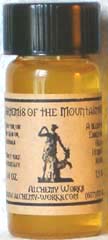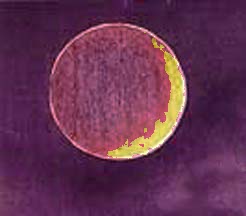I ordered oils this summer from Elizabeth Van Buren and as a clinical aromatherapy student I got them half price! The oils are beautiful and rich.
http://www.elizabethvanburen.com/
The two oils on the left are from Alchemy Works, a magical site at
http://www.alchemy-works.com/
that has a great variety of interesting and hard to find items.
I was drawn in by the description of the
Artemis of the Mountaintop Oil and I bought it along with the
Night Blooming Flying Oil
Here are the descriptions right from the website:
 Artemis of the
Mountaintops Oil
This oil honors the wilder aspects of Artemis,
the virgin goddess. There is some indication
that her worshippers used mugwort or wormwood as aids to prophecy
in her name. I chose five members of the Artemisia family (named for her) for this oil - wormwood,
mugwort, davana, peach artemisia, and dragon's wort - and combined
them in a grounding base
of distilled baked earth. While
still wet, the oil smells very strongly of wormwood, but
as it dries, it changes first to a somewhat minty, fresh scent and
then settles into a lightly fruity sweetness. It's a very
wonderfully virginal with a strong Air quality that sets it
apart from many of my other oils. It's good evoking the wild aspects
of the forest or for honoring
Artemis. She is associated with the wilder parts of the
Old World, especially the dry, stony mountains of the Mediterranean.
There she amuses herself with archery and wide circle dances, according to Callimachus. Although
she is a hunter, she also protects the animals that roam the mountain
forests and dances there with her nymphs. These would paint their
faces white in imitation of the full Moon (she is connected
to the moon as her brother was to the sun) or wear masks made to
look like the dogs she went hunting with; clearly, tapping into
one's wild side is important with this aspect of the divine.
Artemis of the
Mountaintops Oil
This oil honors the wilder aspects of Artemis,
the virgin goddess. There is some indication
that her worshippers used mugwort or wormwood as aids to prophecy
in her name. I chose five members of the Artemisia family (named for her) for this oil - wormwood,
mugwort, davana, peach artemisia, and dragon's wort - and combined
them in a grounding base
of distilled baked earth. While
still wet, the oil smells very strongly of wormwood, but
as it dries, it changes first to a somewhat minty, fresh scent and
then settles into a lightly fruity sweetness. It's a very
wonderfully virginal with a strong Air quality that sets it
apart from many of my other oils. It's good evoking the wild aspects
of the forest or for honoring
Artemis. She is associated with the wilder parts of the
Old World, especially the dry, stony mountains of the Mediterranean.
There she amuses herself with archery and wide circle dances, according to Callimachus. Although
she is a hunter, she also protects the animals that roam the mountain
forests and dances there with her nymphs. These would paint their
faces white in imitation of the full Moon (she is connected
to the moon as her brother was to the sun) or wear masks made to
look like the dogs she went hunting with; clearly, tapping into
one's wild side is important with this aspect of the divine.
 Night Blooming Flying Oil This
floral flying oil focuses strongly on
night-blooming flowers, which release their perfume to
the Moon, not the Sun. I also chose flowers representing
each
of the planetary influences
except Sun, which I figure doesn't have too much of a
role to
play in a flying oil. I included tuberose
and osmanthus (Saturn); gardenia, white rose, and
night-blooming jasmine
(Venus); carnation (Jupiter) and mimosa (Mars). Many
flower
scents, especially those of night-blooming flowers, have
qualities that enhance trancework. In addition, I
included the Moon's favorite, clary sage,
for its divinatory effects. For Mercury, I chose a soft
Australian white sandalwood, which allows the various scents
to work together. Sandalwood also has its own long
tradition in magic
and trancework. I was lucky enough to obtain some very
rare
ingredients for this oil from sources that I trust to
reject
synthetics, as I do. These rare natural perfumes
increase its price, but I think
they are worth it, as they make this oil truly unique.
I'll
wager you will not find anything like this anywhere
else.
Night Blooming Flying Oil This
floral flying oil focuses strongly on
night-blooming flowers, which release their perfume to
the Moon, not the Sun. I also chose flowers representing
each
of the planetary influences
except Sun, which I figure doesn't have too much of a
role to
play in a flying oil. I included tuberose
and osmanthus (Saturn); gardenia, white rose, and
night-blooming jasmine
(Venus); carnation (Jupiter) and mimosa (Mars). Many
flower
scents, especially those of night-blooming flowers, have
qualities that enhance trancework. In addition, I
included the Moon's favorite, clary sage,
for its divinatory effects. For Mercury, I chose a soft
Australian white sandalwood, which allows the various scents
to work together. Sandalwood also has its own long
tradition in magic
and trancework. I was lucky enough to obtain some very
rare
ingredients for this oil from sources that I trust to
reject
synthetics, as I do. These rare natural perfumes
increase its price, but I think
they are worth it, as they make this oil truly unique.
I'll
wager you will not find anything like this anywhere
else.
How could I resist?
I have been drawn to Artemis ever since College freshman Greek and Roman Mythology class when Herb Goldman, my eccentric and quite charismatic professor stood up at the podium and read one of her myths out loud. It sent shivers all over me with a feeling of "This is it! Pay attention!"

This summer I found the notebook from that class when I rummaged through my teenage bedroom closet. There it was! I couldn't even bear to open it because it had held so much power and magic when I was 17 years old, sitting in that huge lecture hall hearing him speak, I was shocked the notebook looked so pedestrian and shabby. I thought it should be glowing with a golden light, not bound in a plastic torn notebook. I still haven't peaked at the myths that caught my soul like silk on a thorn, saying "These are for you. You've heard them before. Listen.."
It made me think of the Carl Sagan quote about writing as a magical act.
“A book is made from a tree. It is an assemblage
of flat, flexible parts (still called "leaves") imprinted with dark
pigmented squiggles. One glance at it and you hear the voice of another
person, perhaps someone dead for thousands of years. Across the
millennia, the author is speaking, clearly and silently, inside your
head, directly to you. Writing is perhaps the greatest of human
inventions, binding together people, citizens of distant epochs, who
never knew one another. Books break the shackles of time ― proof that
humans can work magic.”





No comments:
Post a Comment